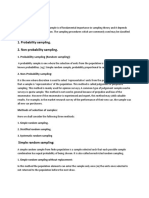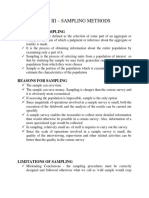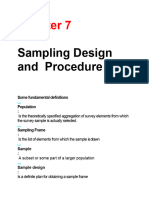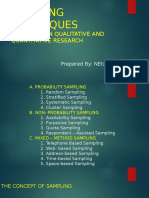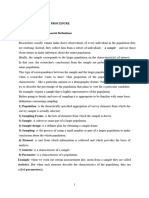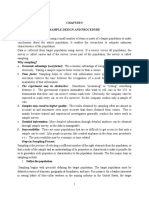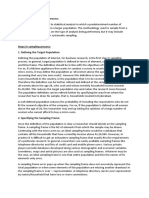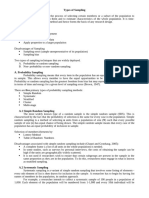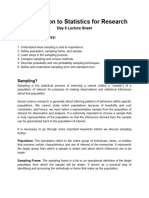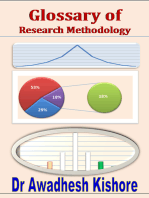0 ratings0% found this document useful (0 votes)
119 viewsSampling and Data Collection
Sampling and Data Collection
Uploaded by
Santosh GhimireThis document discusses sampling methods for research studies. It defines census and sample surveys, with sample surveys being less expensive but still providing accurate information. Probability sampling methods like simple random sampling, stratified sampling, and cluster sampling ensure each item has a chance of selection. Nonprobability methods like convenience sampling and judgment sampling rely on the researcher's discretion. The document provides details on defining the population, sampling frame, sampling unit, determining sample size, and implementing the sampling plan. It compares when census and sampling are appropriate.
Copyright:
Attribution Non-Commercial (BY-NC)
Available Formats
Download as PPTX, PDF, TXT or read online from Scribd
Sampling and Data Collection
Sampling and Data Collection
Uploaded by
Santosh Ghimire0 ratings0% found this document useful (0 votes)
119 views7 pagesThis document discusses sampling methods for research studies. It defines census and sample surveys, with sample surveys being less expensive but still providing accurate information. Probability sampling methods like simple random sampling, stratified sampling, and cluster sampling ensure each item has a chance of selection. Nonprobability methods like convenience sampling and judgment sampling rely on the researcher's discretion. The document provides details on defining the population, sampling frame, sampling unit, determining sample size, and implementing the sampling plan. It compares when census and sampling are appropriate.
Copyright
© Attribution Non-Commercial (BY-NC)
Available Formats
PPTX, PDF, TXT or read online from Scribd
Share this document
Did you find this document useful?
Is this content inappropriate?
This document discusses sampling methods for research studies. It defines census and sample surveys, with sample surveys being less expensive but still providing accurate information. Probability sampling methods like simple random sampling, stratified sampling, and cluster sampling ensure each item has a chance of selection. Nonprobability methods like convenience sampling and judgment sampling rely on the researcher's discretion. The document provides details on defining the population, sampling frame, sampling unit, determining sample size, and implementing the sampling plan. It compares when census and sampling are appropriate.
Copyright:
Attribution Non-Commercial (BY-NC)
Available Formats
Download as PPTX, PDF, TXT or read online from Scribd
Download as pptx, pdf, or txt
0 ratings0% found this document useful (0 votes)
119 views7 pagesSampling and Data Collection
Sampling and Data Collection
Uploaded by
Santosh GhimireThis document discusses sampling methods for research studies. It defines census and sample surveys, with sample surveys being less expensive but still providing accurate information. Probability sampling methods like simple random sampling, stratified sampling, and cluster sampling ensure each item has a chance of selection. Nonprobability methods like convenience sampling and judgment sampling rely on the researcher's discretion. The document provides details on defining the population, sampling frame, sampling unit, determining sample size, and implementing the sampling plan. It compares when census and sampling are appropriate.
Copyright:
Attribution Non-Commercial (BY-NC)
Available Formats
Download as PPTX, PDF, TXT or read online from Scribd
Download as pptx, pdf, or txt
You are on page 1of 7
Sampling: Census is a method of study in which all the items of
population or universe are counted and studied. Census requires more
money, manpower, and time. There are many instances where it is not
practicable to enumerate all the units due to their perishable nature.
When only a part of the population is selected for the study then it is
called sample survey. A sample survey will usually be less expensive
and desired information will be obtained in less time by maintaining
desired degree of accuracy.
Sample survey have following advantages over census survey:
a) Greater scope b) Shorter time lag c) Greater economy
d) Higher quality of work
Sampling is appropriate when: universe is very large, universe possess
homogeneous characteristics, utmost accuracy is not required,
census is impossible (in case of destructive nature of units)
Census is appropriate when: universe is small, population is
heterogeneous, hundred percent accuracy is required.
Sampling process
1. Define the population: In first step population of the study should
be defined. Wrong definition of population will lead meaningless
and misleading findings. A populating must be defined in terms is
elements (price of competing brand), sampling units (department
stores), extent (Kathmandu Valley), and time (from-----to----).
2. Specifying the sampling frame: A sampling frame is a means
which represents the elements of the population. A sampling
frame may be a telephone directory, trade directory, voter list,
employee roster etc,. A perfect sampling frame includes every
element of the population is represented once and only once.
3. Specifying the sampling unit: Sampling unit is the basic unit
which contains the elements of the population to be sampled. For
a family budget survey, sampling unit is household and for
telephone survey, sampling unit is telephone number. Sampling
unit should be further specified that who should be interviewed in
house hole or telephone.
4. Selection of the sampling method: Sampling method is the technique
by following which samples are drawn from the population. In this
step an appropriate method is selected from available methods.
5. Determination of the sample size: It is very important aspect in
sampling because degree of accuracy depends upon size of sample.
Decision of size of sample is based on cost and degree of desired
accuracy.
6. Specification of the sampling plan: The sampling plan involves the
specification of decisions on each of the five steps discussed above.
This steps provides the operational definition of the sampling unit,
starting and ending points, contact procedures, callback procedure,
and other contingencies during interview period.
7. Implication in the field situation: The last step is to implement the
sampling in the field situation. This requires hiring and training
interviewers and assigning duties and responsibilities to field officers,
supervisors and interviewers.
Methods of sampling
Methods of sampling can be divided into two broad categories:
1. Probability sampling: in this method, every element in the
population has a known non-zero probability of being selected as
a sample. This probability is attained through some mechanical
operation of randomization. There are five major methods which
can be used for this purpose:
a) Simple random sampling b)Stratified random sampling
c) Cluster sampling d) Systematic sampling e) Multistage sampling.
2. Nonprobability sampling: in this method samples are not
determined by the chance, but rather by personal judgment or
convenience of the researcher. There are four methods used for
this purpose:
a) Convenience b) Quota c) Judgment d) Snowball
1. Simple random sampling: this is common method of sampling in
which samples are drawn from the population in such a way that
all the items of the population have equal probability of being
selected in the sample. If population is homogeneous and entire
list of population can be listed this method can be used. Table of
random number or lottery method can be used to draw the
sample.
2. Systematic sampling: in this method first sample is randomly
selected and remaining samples are selected at every nth
intervals and ‘n’ is fixed by dividing population size by sample
size.
3. Stratified sampling: when population is heterogeneous and we
want to represent each group in the sample this method can be
used. In this method population is divided into different
homogeneous groups called strata, then simple random sampling
procedure is used to draw sample from each stratum. Samples
may be drawn proportionately or nonproportionately from each
stratum.
4. Cluster sampling: in this method population is divided into different
groups called clusters in such a way that items within the cluster is
heterogeneous and between the cluster is homogeneous. For
example population of a municipality is divided into different wards
and simple random sampling is used to draw samples from each
cluster.
5. Multi-stage sampling: in this method required size of sample is
obtained by sampling in different stages. For example to survey the
yield of a crop in a district, at first stage VDC is selected, in second
stage village is selected, and field is selected in third stage.
1. Convenience sampling: In this method selection of sample is totally
based the convenience of the researcher. When time and money
are seriously limited, this method is widely used.
2. Judgment sampling in this method samples are drawn through
researcher’s intuition or some other subjective basis. The sample
representativeness is highly dependent upon the good judgment of
the researcher.
3. Quota sampling: This method is used to represent different groups
of the population in the sample. in this method population is
broken down on the bases of key demographic characteristics and
samples are drawn.
4. Snowball Sampling: this method is used where respondents are
difficult to identify. Individuals are discovered and are selected for
study. This group is then used to locate others who possess similar
characteristics and who, in turn, identify others.
You might also like
- Bobcat TH t3571 SM 4852150 7-06 OcrbmdDocument1,034 pagesBobcat TH t3571 SM 4852150 7-06 OcrbmdAnem67% (3)
- Narcissist vs. EmpathDocument7 pagesNarcissist vs. EmpathIvonne Sánchez Gálvez100% (2)
- Types of Sampling:: 1. Probability Sampling. 2. Non-Probability SamplingDocument3 pagesTypes of Sampling:: 1. Probability Sampling. 2. Non-Probability Samplinganil gondNo ratings yet
- MANAGERIAL STAT-WPS OfficeDocument4 pagesMANAGERIAL STAT-WPS OfficeJOHN KAMANDANo ratings yet
- BRM Unit 2 NotesDocument17 pagesBRM Unit 2 Notessaniyasaniya5668No ratings yet
- BRM Unit 3Document42 pagesBRM Unit 3prem nathNo ratings yet
- Sample Design and Sampling Procedure: Lesson PlanDocument17 pagesSample Design and Sampling Procedure: Lesson Planmk mayen kurishyNo ratings yet
- Assignment: Probability Sampling DesignDocument7 pagesAssignment: Probability Sampling Designsejal chowhanNo ratings yet
- SaaamplllingDocument9 pagesSaaamplllingD-497 Neha MalviyaNo ratings yet
- HW32983Document6 pagesHW32983Vedika JainNo ratings yet
- Sampling Technique and Sampling DistributionDocument27 pagesSampling Technique and Sampling DistributionimisschesaNo ratings yet
- Tehnik Sampel&penyiapan DataDocument5 pagesTehnik Sampel&penyiapan DataFerial FerniawanNo ratings yet
- BRM Unit-2Document17 pagesBRM Unit-2PunithNo ratings yet
- Research CH 4Document27 pagesResearch CH 4Ebsa AbdiNo ratings yet
- Sampling and Sampling DistributionDocument6 pagesSampling and Sampling DistributiontemedebereNo ratings yet
- Hand Outs Lesson 16 Pr2Document5 pagesHand Outs Lesson 16 Pr2Kristina CassandraNo ratings yet
- Lecture2 Sampling ProcedureDocument33 pagesLecture2 Sampling ProcedureJavier, Kristine MarieNo ratings yet
- CH 7Document11 pagesCH 7fernfern dungoNo ratings yet
- Sampling DistributionDocument72 pagesSampling DistributionSagar YadavNo ratings yet
- Sampling Method in ThesisDocument37 pagesSampling Method in ThesisUsama KHanNo ratings yet
- BR Chapter 6 - Sample Design and Sampling ProcedureDocument18 pagesBR Chapter 6 - Sample Design and Sampling ProcedureAsif Islam SamannoyNo ratings yet
- Sampling DesignDocument19 pagesSampling Designtempmail8281No ratings yet
- Sampling TechniquesDocument19 pagesSampling TechniquesNeil VillasNo ratings yet
- Bus Research Chapter SixDocument10 pagesBus Research Chapter Sixhaymanot gizachewNo ratings yet
- BSRM AssignmentDocument19 pagesBSRM AssignmentKaran NanchahalNo ratings yet
- Sampling Design - Group ThreeDocument38 pagesSampling Design - Group ThreeWasihunNo ratings yet
- lesson10 3Document30 pageslesson10 3irahandrea31No ratings yet
- What Are The Methods of Sampling and Probability Sampling?Document5 pagesWhat Are The Methods of Sampling and Probability Sampling?Stephen MensahNo ratings yet
- Sampling 1Document31 pagesSampling 1Piyush Chitlangia50% (2)
- Module 3Document5 pagesModule 3nasninass67No ratings yet
- CH 5 SamplingDocument5 pagesCH 5 SamplingAsaminow GirmaNo ratings yet
- Sampling MethodsDocument3 pagesSampling Methodsjunkyu kimNo ratings yet
- LEC2 Sampling MethodDocument55 pagesLEC2 Sampling MethodAldrin MndzNo ratings yet
- Research Methods 5-8Document72 pagesResearch Methods 5-8esubalew almawNo ratings yet
- Research CH4Document33 pagesResearch CH4birukmekonen474No ratings yet
- Explain The Sampling ProcessDocument5 pagesExplain The Sampling ProcessChaudhary Taimoor EhsanNo ratings yet
- PR2 Q2 W1 3describing Sample Size and Sampling ProceduresDocument26 pagesPR2 Q2 W1 3describing Sample Size and Sampling ProceduresYanieka MirafloresNo ratings yet
- Sampling TypesDocument4 pagesSampling TypesAmitAmar1990No ratings yet
- ASSIGNMENT 1-1Document9 pagesASSIGNMENT 1-1FrankNo ratings yet
- Introduction To SamplingDocument11 pagesIntroduction To SamplingtekleyNo ratings yet
- SamplingDocument6 pagesSamplingsoniaacio84No ratings yet
- Sampling-hand out mam jazDocument4 pagesSampling-hand out mam jazvillanuevamichael736No ratings yet
- Types of Sampling Lecture NotesDocument4 pagesTypes of Sampling Lecture Notesclaire olitresNo ratings yet
- Lesson 2 StaticsDocument18 pagesLesson 2 StaticsAbu wrdNo ratings yet
- Probability Sampling - According To BJYU's, It Utilizes Some Form of Random Selection. in ThisDocument28 pagesProbability Sampling - According To BJYU's, It Utilizes Some Form of Random Selection. in ThisShiela Louisianne AbañoNo ratings yet
- Determining The Sample PlanDocument25 pagesDetermining The Sample PlankamransNo ratings yet
- Introduction To Sampling Methods: 2.2.1 Finite Population and Infinite PopulationDocument11 pagesIntroduction To Sampling Methods: 2.2.1 Finite Population and Infinite PopulationBhawna JoshiNo ratings yet
- Types of SamplingDocument5 pagesTypes of SamplingakNo ratings yet
- Marketing Assingment: Submitted By: Mohammed Mudassir Submitted To: Prof. Harsha MamDocument18 pagesMarketing Assingment: Submitted By: Mohammed Mudassir Submitted To: Prof. Harsha MamMOHAMMED MUDASSIRNo ratings yet
- Lesson 2 Methods of Data CollectionDocument2 pagesLesson 2 Methods of Data Collectiongraceann adolfoNo ratings yet
- stat2 chapter 1-1Document17 pagesstat2 chapter 1-1tigabie2993No ratings yet
- Day6 STATwithMehediDocument12 pagesDay6 STATwithMehediBIJOY KRISHNANo ratings yet
- Module 3Document5 pagesModule 3vvce22ec0212No ratings yet
- Sampling: Dept. of Psychology Kurukshetra UniversityDocument38 pagesSampling: Dept. of Psychology Kurukshetra UniversityPradeep M VineetaNo ratings yet
- Ethics in Business ResearchDocument28 pagesEthics in Business Researchyashvi bansalNo ratings yet
- Module III-Sampling DesignDocument26 pagesModule III-Sampling DesignSUICIDE SQUAD THAMIZH YTNo ratings yet
- MR Chapter 12Document5 pagesMR Chapter 12IrmileeNo ratings yet
- Chapter 4 Sampling DesignDocument34 pagesChapter 4 Sampling DesignYasinNo ratings yet
- Probability Sam-WPS OfficeDocument4 pagesProbability Sam-WPS Officeinyababausman11No ratings yet
- Introduction: Demystifying The Art of SamplingDocument9 pagesIntroduction: Demystifying The Art of Samplingavnish54321stubbyNo ratings yet
- Sampling Design, Scaling Techniques and Questionnaire DesigningDocument14 pagesSampling Design, Scaling Techniques and Questionnaire DesigningMr MasonNo ratings yet
- 2005-2015 Nissan Vehicles - Ecm Reprogramming - Service Information PDFDocument1 page2005-2015 Nissan Vehicles - Ecm Reprogramming - Service Information PDFTung NguyenNo ratings yet
- Paye Guide KenyaDocument68 pagesPaye Guide KenyaLazarus OthienoNo ratings yet
- Berlinda Owusu: Professional ProfileDocument4 pagesBerlinda Owusu: Professional Profileokatakyie1990No ratings yet
- Diagnostic AgentsDocument4 pagesDiagnostic Agentsrajesh8340590932No ratings yet
- Diaphragm Ultrasound As A New Method To Predict Extubation Outcome in Mechanically VentilaDocument7 pagesDiaphragm Ultrasound As A New Method To Predict Extubation Outcome in Mechanically VentilaSilvanaNo ratings yet
- Environment - Sample Answers and Topic Vocabulary For IELTS Speaking Exam - TheTestTakerDocument31 pagesEnvironment - Sample Answers and Topic Vocabulary For IELTS Speaking Exam - TheTestTakerAlejandro Sosa De GreefNo ratings yet
- HIRA for U- Girder Casting YardDocument11 pagesHIRA for U- Girder Casting YardNisanth ThulasidasNo ratings yet
- Manual Válvula Solenoide Con Control de Flujo OrbitDocument2 pagesManual Válvula Solenoide Con Control de Flujo Orbitjdum133317No ratings yet
- Actuarial Data CycleDocument3 pagesActuarial Data CycleKevin Swamber100% (2)
- Compresor CTN3B 11 11273Document30 pagesCompresor CTN3B 11 11273adm.chahuinNo ratings yet
- Principal's Message: Math in The Real WorldDocument14 pagesPrincipal's Message: Math in The Real WorldCTIVVCVNo ratings yet
- 16-Week Powerlifting/Bodybuilding Hybrid Program: Weeks 1-6Document11 pages16-Week Powerlifting/Bodybuilding Hybrid Program: Weeks 1-6JackNo ratings yet
- Biology Score: Chapter 7: MutationDocument15 pagesBiology Score: Chapter 7: MutationabbyNo ratings yet
- SDS - Fenomastic Enamel Semigloss - English (Uk) - DubaiDocument5 pagesSDS - Fenomastic Enamel Semigloss - English (Uk) - DubaiBalasubramanian AnanthNo ratings yet
- ASTER Accurately Estimating The Number of Cell TypDocument3 pagesASTER Accurately Estimating The Number of Cell TypNealNo ratings yet
- Environmental Quality Act 1974: Scheduled Wastes and Water Pollution ControlDocument71 pagesEnvironmental Quality Act 1974: Scheduled Wastes and Water Pollution ControlAifaa ArinaNo ratings yet
- HACCP Plan TemplateDocument15 pagesHACCP Plan Templatearef alsakkaf50% (2)
- Cookery 9 6th Week Summative TestDocument2 pagesCookery 9 6th Week Summative Testaaliyah gallegoNo ratings yet
- Lucas 2016Document12 pagesLucas 2016Devi RajaswariNo ratings yet
- Harvest Moon - MFoMT RecipesDocument12 pagesHarvest Moon - MFoMT RecipesSashi MehNo ratings yet
- Nutrients: Vitamin D Deficiency and Outcome of COVID-19 PatientsDocument13 pagesNutrients: Vitamin D Deficiency and Outcome of COVID-19 PatientsCalx ingNo ratings yet
- GUIDELINE For IMPROVING OUTCOME After Anaesthesia and Critical Care - 2017 - College of AnaesthesiologistsDocument83 pagesGUIDELINE For IMPROVING OUTCOME After Anaesthesia and Critical Care - 2017 - College of AnaesthesiologistsSanj.etcNo ratings yet
- Acute Kidney Injury, Dengue Shock Syndrome, and Severe DehydrationDocument28 pagesAcute Kidney Injury, Dengue Shock Syndrome, and Severe DehydrationPuskesmas BuloilaNo ratings yet
- Canusa HBE Brush Grade Installation GuideDocument2 pagesCanusa HBE Brush Grade Installation GuideleoNo ratings yet
- MIMS ReviewerDocument11 pagesMIMS ReviewerZini RodilNo ratings yet
- Control and GrafcetDocument4 pagesControl and Grafcetdarthvader909No ratings yet
- Act 4 SnehaDocument5 pagesAct 4 SnehajayadevmotamarriNo ratings yet
- Endotracheal Tubes: Tube Tip DesignDocument9 pagesEndotracheal Tubes: Tube Tip DesignAce Dioso TubascoNo ratings yet


